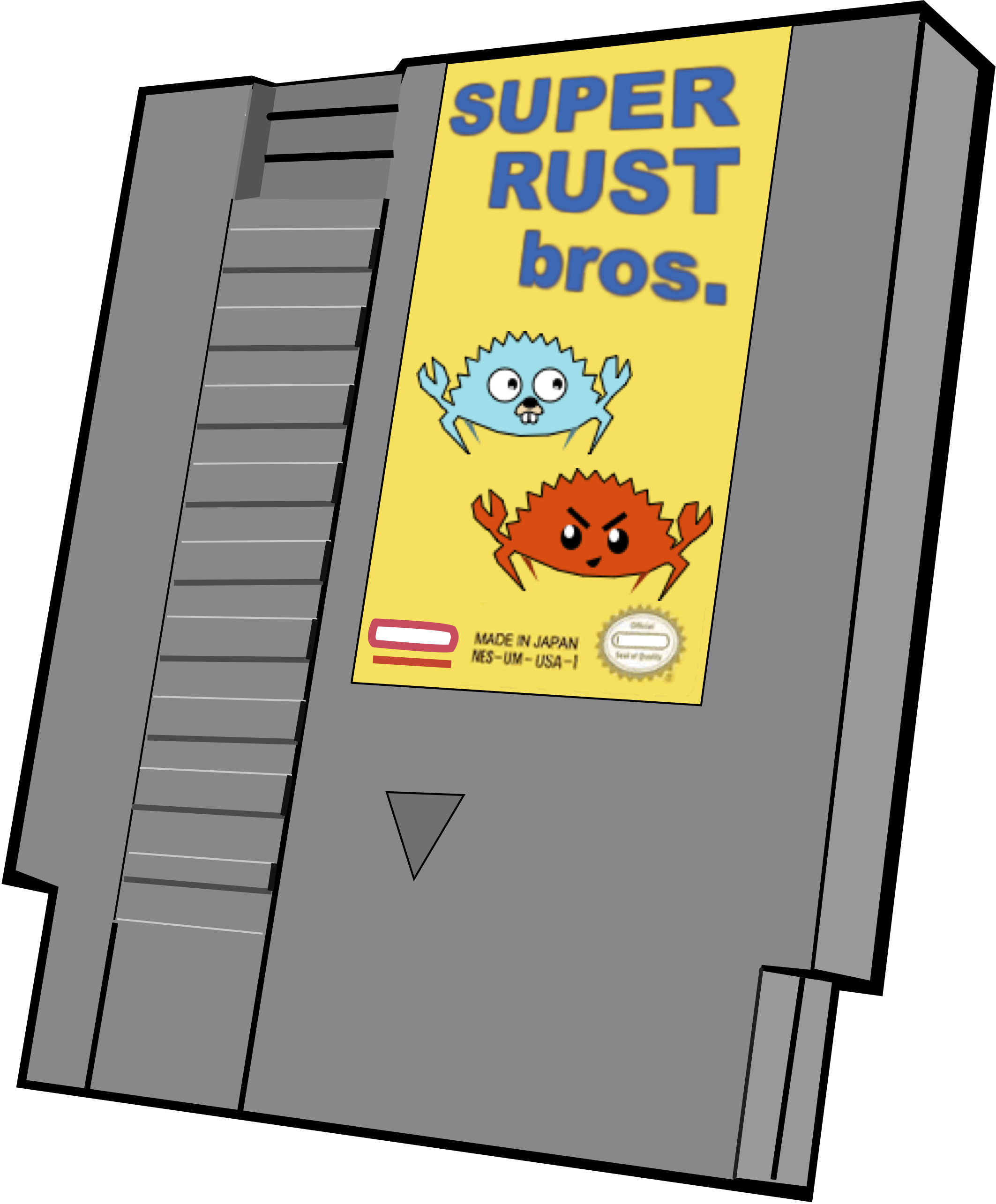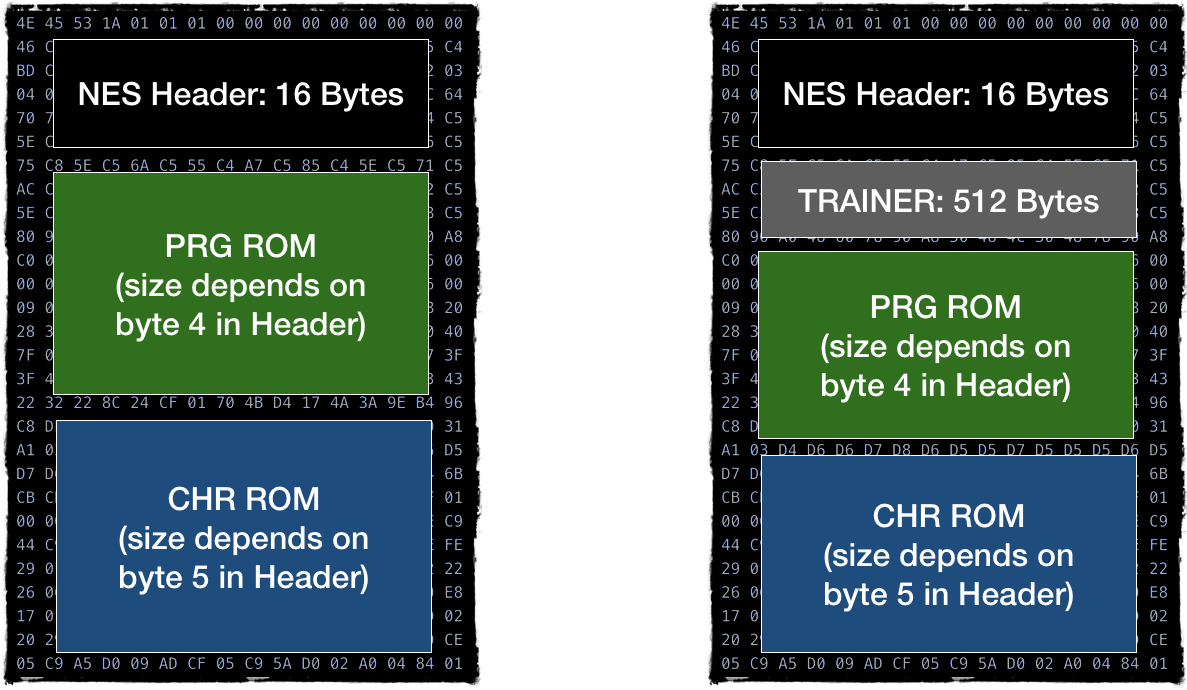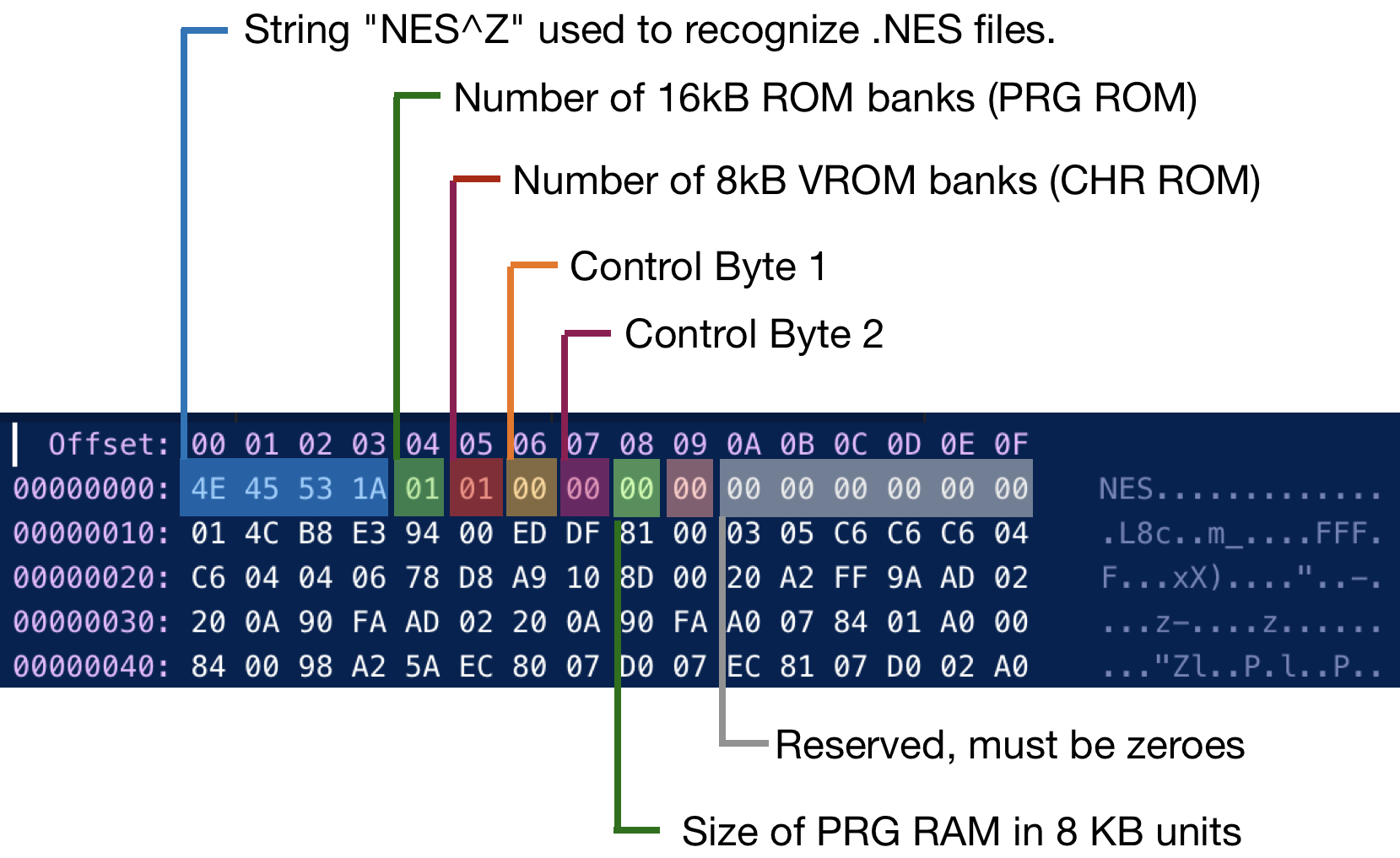Cartridges

The first version of the cartridges was relatively simple. They carried two banks of ROM memory: PRG ROM for code and CHR ROM for visual graphics.
Upon insertion into the console, PRG ROM gets connected to CPU, and CHR ROM gets connected to PPU. So on a hardware level, CPU wasn't able to access CHR ROM directly, and PPU wasn't able to access PRG ROM.
Later versions of cartridges had additional hardware:
- mappers to provide access to extended ROM memory: both CHR ROM and PRG ROM
- extra RAM (with a battery) to save and restore a game state
However, we won't be working with cartridges. Emulators work with files containing dumps of ROM spaces.
There are several file formats for ROM dumps; the most popular one is iNES designed by Marat Fayzullin

The file contains 3-4 sections:
- 16-byte header
- optional 512 bytes of the so-called Trainer, a data section created by Famicom copiers to keep their own mapping. We can skip this section if it is present.
- Section containing PRG ROM code
- Section containing CHR ROM data
The header is the most interesting part.

Control Byte 1 and Control Byte 2 (Byte 06 and 07 in the header) contain some additional info about the data in file, but it's packed in bits.
 |  |
We won't cover and support the iNES 2.0 format as it's not very popular. But you can find the formal specification of both iNES versions.
The bare minimum information we care about:
- PRG ROM
- CHR ROM
- Mapper type
- Mirroring type: Horizontal, Vertical, 4 Screen
Mirroring will be extensively covered in the following PPU chapters. For now, we need to figure out which mirroring type the game is using.
We would support only the iNES 1.0 format and mapper 0.
Mapper 0 essentially means "no mapper" that CPU reads both CHR and PRG ROM as is.
Let's define cartridge Rom data structure:
#![allow(unused)] fn main() { #[derive(Debug, PartialEq)] pub enum Mirroring { Vertical, Horizontal, FourScreen, } pub struct Rom { pub prg_rom: Vec<u8>, pub chr_rom: Vec<u8>, pub mapper: u8, pub screen_mirroring: Mirroring, } }
Then we need to write the code to parse binary data:
#![allow(unused)] fn main() { impl Rom { pub fn new(raw: &Vec<u8>) -> Result<Rom, String> { if &raw[0..4] != NES_TAG { return Err("File is not in iNES file format".to_string()); } let mapper = (raw[7] & 0b1111_0000) | (raw[6] >> 4); let ines_ver = (raw[7] >> 2) & 0b11; if ines_ver != 0 { return Err("NES2.0 format is not supported".to_string()); } let four_screen = raw[6] & 0b1000 != 0; let vertical_mirroring = raw[6] & 0b1 != 0; let screen_mirroring = match (four_screen, vertical_mirroring) { (true, _) => Mirroring::FourScreen, (false, true) => Mirroring::Vertical, (false, false) => Mirroring::Horizontal, }; let prg_rom_size = raw[4] as usize * PRG_ROM_PAGE_SIZE; let chr_rom_size = raw[5] as usize * CHR_ROM_PAGE_SIZE; let skip_trainer = raw[6] & 0b100 != 0; let prg_rom_start = 16 + if skip_trainer { 512 } else { 0 }; let chr_rom_start = prg_rom_start + prg_rom_size; Ok(Rom { prg_rom: raw[prg_rom_start..(prg_rom_start + prg_rom_size)].to_vec(), chr_rom: raw[chr_rom_start..(chr_rom_start + chr_rom_size)].to_vec(), mapper: mapper, screen_mirroring: screen_mirroring, }) } } }
As always, don't forget to test!
Next, connect Rom to the BUS:
#![allow(unused)] fn main() { pub struct Bus { cpu_vram: [u8; 2048], rom: Rom, } impl Bus { pub fn new(rom: Rom) -> Self { Bus { cpu_vram: [0; 2048], rom: rom, } } //.... } }
And finally, we need to map address space [0x8000 … 0x10000] to cartridge PRG ROM space.
One caveat: PRG Rom Size might be 16 KiB or 32 KiB. Because [0x8000 … 0x10000] mapped region is 32 KiB of addressable space, the upper 16 KiB needs to be mapped to the lower 16 KiB (if a game has only 16 KiB of PRG ROM)
#![allow(unused)] fn main() { impl Mem for Bus { fn mem_read(&self, addr: u16) -> u8 { match addr { //…. 0x8000..=0xFFFF => self.read_prg_rom(addr), } } fn mem_write(&mut self, addr: u16, data: u8) { match addr { //... 0x8000..=0xFFFF => { panic!("Attempt to write to Cartridge ROM space") } } } } impl Bus { // ... fn read_prg_rom(&self, mut addr: u16) -> u8 { addr -= 0x8000; if self.rom.prg_rom.len() == 0x4000 && addr >= 0x4000 { //mirror if needed addr = addr % 0x4000; } self.rom.prg_rom[addr as usize] } } }
You can download your first NES ROM dump file on Github.
You will need to modify the main method to load binary from a file.
Spoiler alert: it's a modification of a snake game with funkier physics. The game expects the same memory map for the input device, screen output, and random number generator.
The full source code for this chapter: GitHub